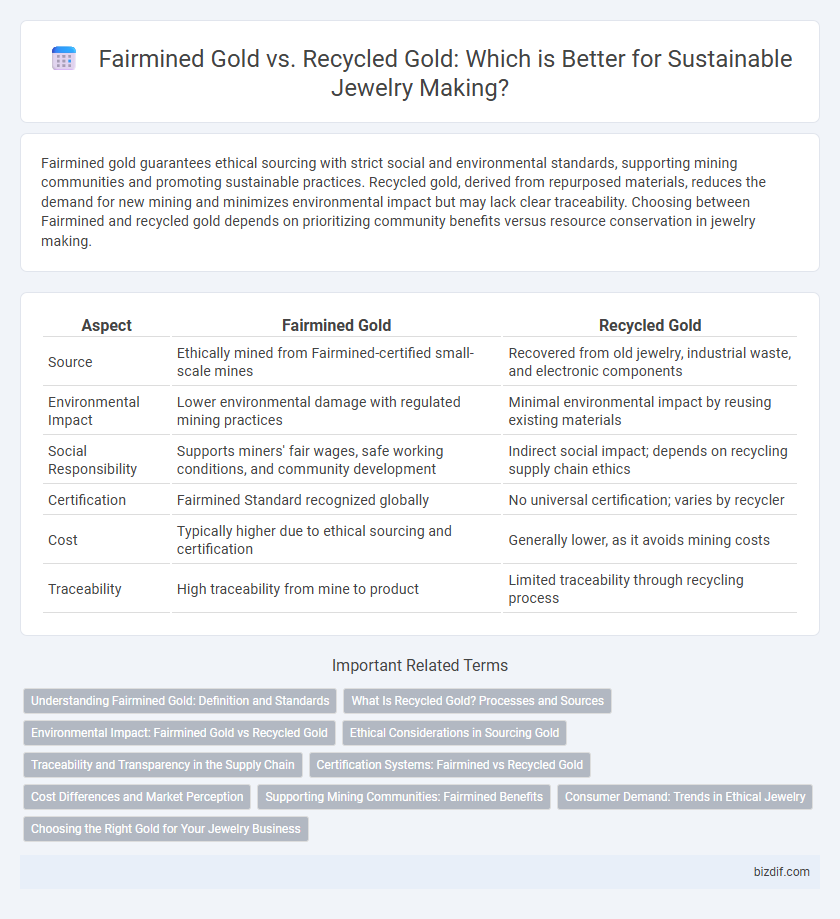Fairmined gold guarantees ethical sourcing with strict social and environmental standards, supporting mining communities and promoting sustainable practices. Recycled gold, derived from repurposed materials, reduces the demand for new mining and minimizes environmental impact but may lack clear traceability. Choosing between Fairmined and recycled gold depends on prioritizing community benefits versus resource conservation in jewelry making.
Table of Comparison
| Aspect | Fairmined Gold | Recycled Gold |
|---|---|---|
| Source | Ethically mined from Fairmined-certified small-scale mines | Recovered from old jewelry, industrial waste, and electronic components |
| Environmental Impact | Lower environmental damage with regulated mining practices | Minimal environmental impact by reusing existing materials |
| Social Responsibility | Supports miners' fair wages, safe working conditions, and community development | Indirect social impact; depends on recycling supply chain ethics |
| Certification | Fairmined Standard recognized globally | No universal certification; varies by recycler |
| Cost | Typically higher due to ethical sourcing and certification | Generally lower, as it avoids mining costs |
| Traceability | High traceability from mine to product | Limited traceability through recycling process |
Understanding Fairmined Gold: Definition and Standards
Fairmined gold is a certification standard ensuring gold is sourced from responsible artisanal and small-scale mining organizations that meet rigorous social, environmental, and labor criteria. This standard guarantees fair wages, safe working conditions, and environmental protection while promoting community development. Unlike recycled gold, which originates from remelted existing metals, Fairmined gold supports ethical mining practices and sustainable livelihoods in mining communities.
What Is Recycled Gold? Processes and Sources
Recycled gold is sourced from pre-existing jewelry, electronic components, and industrial gold waste, reducing the need for new mining activities. The recycling process involves melting down old gold items, refining to remove impurities, and re-casting into new forms suitable for jewelry making. This sustainable practice helps conserve natural resources and lowers the environmental footprint associated with gold extraction.
Environmental Impact: Fairmined Gold vs Recycled Gold
Fairmined gold is sourced from artisanal and small-scale mines that adhere to strict environmental standards, reducing harmful ecological effects through responsible mining practices. Recycled gold minimizes environmental impact by reusing existing metals, thereby avoiding new mining operations and conserving natural resources. Both options significantly lower carbon footprints compared to conventional gold mining but differ in resource extraction methods and supply chain transparency.
Ethical Considerations in Sourcing Gold
Fairmined gold is certified to ensure responsible mining practices that protect labor rights and environmental sustainability, making it a preferred choice for ethically conscious jewelers. Recycled gold reduces the need for new mining by reusing existing materials, thereby minimizing environmental impact and promoting circular economy principles. Both sourcing methods prioritize ethical considerations, but Fairmined gold guarantees social accountability through rigorous certification standards.
Traceability and Transparency in the Supply Chain
Fairmined gold ensures rigorous traceability and transparency, certified by the Alliance for Responsible Mining, guaranteeing ethical sourcing from verified artisanal mining communities. Recycled gold, sourced from pre-existing jewelry or industrial materials, offers a sustainable alternative but often lacks comprehensive supply chain documentation. Both options promote environmental responsibility, yet Fairmined gold provides a higher standard of traceability through strict certification processes.
Certification Systems: Fairmined vs Recycled Gold
Fairmined gold certification ensures traceability and ethical mining practices by supporting small-scale miners who meet stringent social, environmental, and economic standards. Recycled gold certification typically verifies that gold is sourced from pre-existing jewelry or industrial materials, minimizing environmental impact without new mining activities. Both systems promote sustainable jewelry making but emphasize different origins and ethical criteria for responsible sourcing.
Cost Differences and Market Perception
Fairmined gold typically commands a higher price due to its certified ethical sourcing standards that support artisanal miners and promote environmental sustainability. Recycled gold often costs less, benefiting from lower extraction expenses and a reduced environmental footprint, appealing to eco-conscious consumers. Market perception favors Fairmined gold for its traceability and social impact, while recycled gold gains traction for its circular economy benefits and cost-effectiveness.
Supporting Mining Communities: Fairmined Benefits
Fairmined gold guarantees ethical sourcing by supporting small-scale mining communities with fair wages, safe working conditions, and environmental stewardship. This certification fosters sustainable development, empowering miners through social investments and promoting transparency in the supply chain. Recycled gold reduces environmental impact but lacks the direct social benefits and community support emphasized by Fairmined standards.
Consumer Demand: Trends in Ethical Jewelry
Consumer demand for ethical jewelry increasingly favors Fairmined gold due to its verified origins from responsible artisanal mining communities, promoting social and environmental benefits. Recycled gold remains popular for its sustainability and lower environmental impact by reusing existing materials without new mining. Trends indicate a growing preference for transparency and traceability, with consumers prioritizing both Fairmined certification and recycled content in their jewelry choices.
Choosing the Right Gold for Your Jewelry Business
Fairmined gold guarantees ethical sourcing from responsible artisanal mines, ensuring transparency and social impact, while recycled gold promotes sustainability by reducing the demand for new mining and minimizing environmental harm. Jewelry businesses prioritizing ethical labor practices and community development benefit from Fairmined certification, whereas those focused on maximizing eco-friendly materials and circular economy principles lean towards recycled gold. Evaluating customer values and brand identity helps in selecting gold that aligns with both environmental responsibility and market differentiation.
Fairmined gold vs Recycled gold Infographic

 bizdif.com
bizdif.com